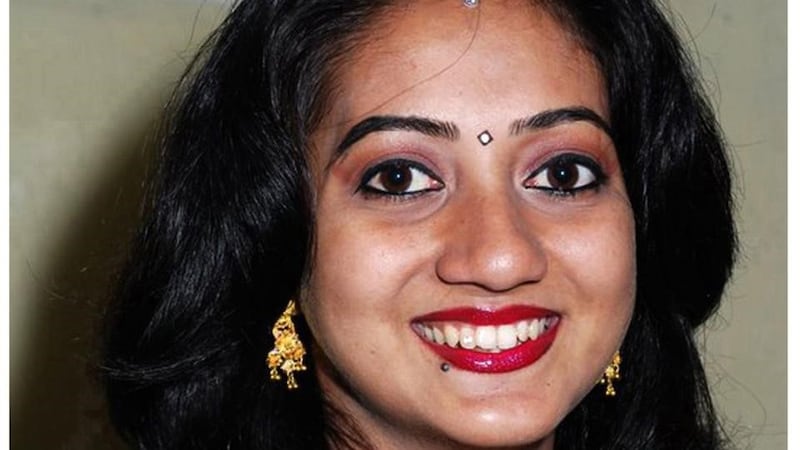Savita Halappanavar died almost 10 years ago, on October 28th, 2012. On Saturday, October 29th, as Galway’s Indian community celebrate their biggest festival, Diwali, a minute’s silence will be observed in her memory.
In Dublin, a march is planned in remembrance of how her death partly inspired one of the largest movements for social change seen in Ireland. It will also call for reforms of current abortion legislation.
“It’s really important to remember Savita’s death,” says Orla O’Connor, director of the National Women’s Council of Ireland (NWCI) and co-director of Together For Yes, which sought a ‘yes’ vote in the 2018 referendum on repealing the Eighth Amendment.

How the death of Savita Halappanavar changed the course of modern Irish history
Whether one agrees or disagrees that Savita’s death was caused by Article 40.3.3 of the Constitution, she is “linked to the campaign, to the referendum and repeal [of the Eighth Amendment], and will be forever,” says O’Connor.
RM Block
Article 40.3.3, passed in a referendum on September 7th, 1983, by a majority vote of 66.9 per cent, guaranteed the State would “defend and vindicate” the “right to life of the unborn…with due regard to the equal right to life of the mother”. It was repealed, by a majority vote of 66.4 per cent, on May 25th, 2018.
Just brilliant. She was very, very bubbly, very cheerful, not a bit of sadness or gloom
Savita – who will perhaps always been known by her first name – arrived in Galway in July 2008. The then 26-year-old dentist, from Belgaum in the south-west Indian state of Karnataka, was the youngest of three and the only daughter of Andanappa and Akhmedevi Yalagi.
She met her husband Praveen Halappanavar, who had been working for Boston Scientific in Galway for two years, on the matrimony and matchmaking website Shaadi.com. With her father Andanappa’s blessing, they married in Belgaum in April 2008.
Harshad Holehonnur, who shared an apartment with Praveen in Ballybrit before the marriage, remembered Savita this week as: “Just brilliant. She was very, very bubbly, very cheerful, not a bit of sadness or gloom.”

She was called “the girl with the diamond smile” and not just because she had a tiny diamond in one of her teeth. Her personality shone, said Holehonnur. Children used to ask her where she got the diamond and she would laugh: ‘Oh, you’ll have to go to India to get one’.
In July 2012, she passed her Irish Dental Council examinations and was granted a licence to practise in Ireland. In the same month, she was delighted to learn she was pregnant.
In October, two days before her parents, who were visiting, were due to go home, Savita developed severe back pain.
On Sunday 21st, Savita and Praveen attended the emergency department at Galway University Hospital (GUH). Now 17 weeks pregnant, Savita was told she was miscarrying and admitted to St Monica’s Ward.
[ Abortion case study: Two doctors and their polar views on terminationOpens in new window ]
Over the following two days, in severe pain and anxious to get home to her parents before they left, she asked repeatedly for the pregnancy to be terminated but was told under Irish law it was not possible while a foetal heartbeat was present.
On Tuesday 23rd, midwife Anna Maria Burke, anxious to explain to Savita, who was Lingayat Hindu, why she could not have the termination, told her it was because: “This is a Catholic country”.
By early morning on Wednesday 24th, Savita had sepsis. That afternoon she spontaneously delivered a stillborn female foetus, whom she named Prasa, and was transferred to the high-dependency unit.
On Thursday 25th, she was transferred to intensive care, progressing towards septic shock. Throughout Thursday she remained critically ill.
[ How the death of Savita Halappanavar revolutionised IrelandOpens in new window ]
Her temperature at 9am on Friday 26th was 40 degrees and she had an elevated heart rate of 140 bpm. Savita continued to deteriorate, despite the administration of a range of supports and antibiotics. Sepsis was now engulfing her body.
Through the morning of Saturday 27th she remained critically ill. At about 4pm, she deteriorated suddenly and dramatically, becoming highly contusive and hypoxic – bruised in appearance due low oxygen saturation levels.
Through the day her condition became more extreme. Her heart rate was 150 to 155 bpm, her lactate levels were 24, grossly exceeding the desirable level of 1.5, and she was described as “very oedematous, fingers flexed tightly, feet extended and very stiff”.
At 10pm, alarms rang on Savita’s ventilator and she was given an intravenous infusion of cisatracurium, a drug to relax her skeletal muscles to help her breathe. At 11pm, she remained unresponsive. At midnight she was washed, and her bloodstained pads were changed. When the nurses tried to turn Savita, her heart rate increased from 140 bpm to 190 pm, so they stopped to let her heart rate settle.
The doctor saw me. She came to me and said, Do you know what is happening? Savita is dying
Between 12.30am and 12.45am on Sunday 28th, as three ICU nurses sat by Savita’s bed, the monitor showed her heart rate becoming chaotic. Her pulse was not palpable. CPR was commenced by Dr Aoife Quinn, staff nurses Veronica Rafftery, Therese Connolly, Jeurgen Schone, Aine Nic an Bheath and Jacinta Gately.
After several minutes, nurse Gately ran to get Praveen, who was waiting with friends outside intensive care. She told him Savita’s heart had stopped, that they had commenced CPR. She asked him if he wanted to be present. He said he did. She took his hand and asked if he knew what was happening: that they were losing her.
Praveen recalled a “big team” around his wife. “They were pumping her heart,” he told this reporter in the weeks afterwards. “The doctor saw me. She came to me and said, ‘Do you know what is happening? Savita is dying.’ They were commencing compressions.”
CPR continued until after 1am on October 28th, when a decision was made to stop. Savita suffered a pulseless cardiac arrest. At 1.09am, Savita died.

Praveen brought his wife’s remains home to Belgaum for burial, leaving her bewildered friends in Galway trying to make sense of what had happened. Abortion had been legal in India since 1971. “We could not understand it, not at all,” says Holehonnur.
It was the 20th anniversary of the X case, in which the Supreme Court had ruled a suicidal, pregnant 14-year-old was entitled to an abortion under the strictures of the Eighth Amendment. The Government was under pressure from the European Court of Human Rights to legislate for the X case. Pro-choice activists were mobilising to ramp up pressure, among them activists in Galway who held a stall on Shop Street most Saturdays.
Savita’s friends approached them for advice. The activists contacted The Irish Times, leading to this reporter travelling to Galway on November 9th, 2012, and being introduced to Dr Chalikonda Prasad, a friend of Praveen’s family. From his home in Spiddal, by mobile phone, Praveen’s account was given.
On Wednesday, November 14th, the story ran in The Irish Times under the headline, “Woman ‘denied a termination’ dies in hospital”. It was illustrated with a photograph of Savita, wearing her Diwali costume from the previous year.

O’Connor says a vigil outside Leinster House – one of many across the State that evening – was “really incredible, not only because of the volume of people but because it was the first time I’d seen so many people come out who had never been on a march about abortion before”.
Veteran abortion rights activist Ailbhe Smith was in London that morning visiting her daughter. “I just got on a plane and came home. I came to the vigil straight off the plane. I was horrified, outraged and there and then, on the spot, said: ‘Right, this is it. This is crunch time.’ ”
Smith describes the vigils, and the march the following Saturday in Dublin of up to 20,000 people, as “the breaking point” in the almost 30-year campaign to change Ireland’s legal approach to abortion.
It was palpable, that emotional response, of people crying salt, bitter tears for somebody they didn’t know. They were crying because they felt powerless, that something had to be done
“Savita’s death was a trigger, a spark, and what it enabled was emotion. People really felt this in their hearts and when people feel something in their hearts, they will do something about it. It was palpable, that emotional response, of people crying salt, bitter tears for somebody they didn’t know. They were crying because they felt powerless, that something had to be done. And at some level it was about them, their lives, and what’s important.
“It was absolutely written in from that vigil. That was the moment the centre could not hold. It broke. It was people who broke it, who poured out on to the street because they were in grief – about Savita, of course, but about a lot of other things as well.”
The political ground started to shift too, with Government TDs such as Simon Harris reconsidering their views. Meath East TD Regina Doherty said: “I am anti-abortion and pro-life, but I am pro my own life and the lives of my children.”
It’s important not to forget, there was pushback against the idea of a referendum. We had to fight for that
For several days, on RTÉ Radio One’s Liveline programme, women began telling their abortion stories. Many described the isolation, shame, fear and pain they had felt, and the near total absence of support they had often experienced in Ireland.
It would be six years, however, before the proposal to repeal the Eighth Amendment would be put to the electorate. “It’s important not to forget,” says O’Connor, “there was pushback against the idea of a referendum. We had to fight for that”.
In January 2013, a joint Oireachtas committee held hearings on legislating for the X case. That led to the Protection of Life During Pregnancy Act. Also that year there were three investigations conducted: by the Health Service Executive; by the Health Information and Quality Authority; and a coroner’s inquest. Each found Savita died as a result of a mismanaged miscarriage, and that the legal situation prevented an abortion that could have saved her life.
In May 2015, a 61.7 per cent vote in favour of marriage equality was seen by some as indicative that a referendum on repealing the Eighth Amendment could pass. In April 2017, a Citizens’ Assembly recommended Article 40.3.3 should not be retained, and that abortion should be available without restriction as to reason up to 12 weeks. The Oireachtas Committee on the Eighth Amendment, convened the same month, recommended repeal of the amendment.
In January 2018, then taoiseach Leo Varadkar confirmed a referendum would be held in May. The landslide majority five months later was demonstration of a “quiet revolution” over the preceding “10 or 20 years”, he said.
A significant minority were distraught. Bishop of Elphin, Kevin Doran, told The Irish Times this week: “The sadness of Savita’s death has been multiplied many times over by the manner in which it was used to promote the legalisation of abortion in Ireland. The removal of the Eighth Amendment from the Irish Constitution has resulted in the deaths of thousands of babies each year, many of whom are mourned in private.”
For many, this was their time to have their voices heard. We would not have won so heftily without the votes of older people
A contributing factor to the referendum result were the voices of women telling their stories, including older women recalling difficult personal experiences in previous decades. “For many, this was their time to have their voices heard,” says Smith. “We would not have won so heftily without the votes of older people.”
Crucial also were the voices of women who had to travel to terminate pregnancies with fatal foetal abnormalities (FFAs), and some campaigners say these women continue to be “failed” by the current legislation.
The Health (Regulation of Termination of Pregnancy) Act 2018 permits abortion on request to 12 weeks, with a mandatory three-day wait between seeking an abortion and accessing abortifacient medication, and thereafter where there is a threat to the mother’s life or health. Last year, there were about 6,700 abortions in Ireland.
[ Savita Halappanavar’s parents ‘really, really happy’ after abortion voteOpens in new window ]
The legislation provides abortion in FFA cases where two doctors certify in good faith that the baby will die within 28 days of birth. It means that women with FFAs, where doctors cannot be certain that death will occur within that timeframe, must still travel if they want an abortion. Of the 206 Irish women who accessed abortion in Britain last year, half were FFA cases.
But Eilis Mulroy of the Pro Life Campaign says the legislation takes no account of the one in three voters who voted against repeal, and she describes as “unfair and disingenuous” the invocation “of the 10-year anniversary of the tragic death of Savita Halappanavar to push for an even more extreme expansion of the Irish abortion law”.
When asked whether – given that the public voted already for the abortion regime now in place – it is wrong to seek further changes, the NWCI disagreed, saying the electorate was offered a vote only on repeal. It argued that its research, published in February, demonstrated wide public support for greater liberalisation.

Minister for Health Stephen Donnelly is awaiting a review of the operation of the Act from barrister Marie O’Shea. She is understood to be on track to deliver the review by the end of the year.
Savita’s husband Praveen has remarried and is living in San Jose, California. Her father Andanappa died shortly after the repeal of the Eighth Amendment, but had said he was “really, really happy” to learn of the result. Her brother Sanjeev says he supports the upcoming march.
After the referendum result was announced, people gathered to lay flowers and other tokens near a mural of Savita painted by the graffiti artist Aches in Portobello, Dublin. One note left there read: “Sorry we were too late, but we’re here now. We didn’t forget you.”




















